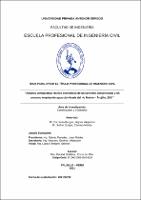Análisis comparativo técnico económico de un concreto convencional y un concreto empleando agua clorificada del río Moche – Trujillo, 2021

View/
Download
(application/pdf: 166.0Kb)
(application/pdf: 166.0Kb)
Date
2022Author(s)
Carranza Burgos, Neyser Alejandro
Sullon Quispe, Carmen Marley
Metadata
Show full item recordAbstract
La presente investigación propone utilizar una alternativa al uso de agua potable
para la fabricación y curado del concreto (hormigón), debido a que es el material
más usado en la industria de la construcción y por lo tanto existe una alta demanda.
Se ha planteado utilizar el agua del río Moche para lo cual en primera instancia se
hizo un análisis físico – químico con el propósito de evaluar si las propiedades no
excedían los límites que establece la norma técnica peruana, al arrojar resultados
aceptables ya no fue necesario el uso de un tratamiento con cloro y se procedió a
utilizarla directamente como agua de mezcla y curado para el concreto. Para
evaluar las características del concreto en estado fresco y endurecido se hizo una
dosificación de mezcla para un concreto f’c = 210 kg/cm2 siguiendo la normativa
que establece el ACI 211.1 utilizando los datos de los ensayos correspondientes a
la caracterización de los agregados provenientes de la Cantera Quebrada El León.
Para ensayos de resistencia a la compresión se elaboraron 24 probetas usando
agua potable y 24 usando agua del río Moche, las cuales fueron ensayadas en lotes
de 6 unidades a las edades de 1, 3, 7 y 28 días. El ensayo de resistencia a la
compresión es generalmente el que nos indica la calidad de un concreto y para
nuestro estudio se obtuvo para el agua del río Moche una resistencia a los 28 días
de 343 kg/cm2 y para el concreto con agua potable de 350 kg/cm2
, siendo ambos
resultados aceptables ya que sobrepasa la resistencia para la cual fueron
diseñados. Asimismo, se fabricaron 3 vigas usando agua potable y 3 vigas usando
agua del río Moche para ensayarlos a flexión y se calculó un módulo de rotura para
concreto con agua potable de 6.54 y 6.07 para concreto, resultando valores
aceptables para ambos tipos de concreto. Finalmente se hizo un análisis económico
para 1 m3 de concreto elaborado usando agua potable y otro usando agua del río
Moche, teniendo un costo de S/ 324.40 y S/ 323.84 respectivamente. Finalmente
se determinó que el concreto elaborado con agua del río Moche es una alternativa
viable de utilizar, ya que arroja resultados mayores a los esperados técnicamente
y también es más económico en S/0.56 con respecto al concreto convencional. The present research proposes to use an alternative to the use of drinking
water for the manufacture and curing of concrete (concrete), because it is the
most used material in the construction industry and therefore there is a high
demand. It has been proposed to use the water from the Moche River for which
in the first instance a physical-chemical analysis was carried out in order to
evaluate if the properties did not exceed the limits established by the Peruvian
technical standard, when yielding acceptable results, it was no longer
necessary to use of a chlorine treatment and proceeded to use it directly as
mixing and curing water for concrete. To evaluate the characteristics of the
concrete in the fresh and hardened state, a mixture dosage was made for a
concrete f'c = 210 kg / cm2 following the regulations established by ACI 211.1
using the data from the tests corresponding to the characterization of the
aggregates from from the Quebrada El León Quarry. For compressive
strength tests, 24 specimens were made using potable water and 24 using
water from the Moche River, which were tested in batches of 6 units at the
ages of 1, 3, 7 and 28 days. The compressive strength test is generally the one
that indicates the quality of a concrete and for our study a resistance to 28
days of 343 kg / cm2 was obtained for the water of the Moche river and for the
concrete with drinking water of 350 kg / cm2, both results being acceptable
since it exceeds the resistance for which they were designed. Likewise, 3
beams were manufactured using potable water and 3 beams using water from
the Moche River to test them in flexion, and a modulus of rupture for concrete
with potable water of 6.54 and 6.07 for concrete was calculated, resulting in
acceptable values for both types of concrete. Finally, an economic analysis
was made for 1 m3 of concrete made using potable water and another using
water from the Moche River, having a cost of S / 324.40 and S / 323.84
respectively. Finally, it was determined that concrete made with water from
the Moche River is a viable alternative to use, since it yields higher results
than technically expected and is also S / 0.56 cheaper than conventional
concrete.
Collections
- Ingeniería Civil [1260]

